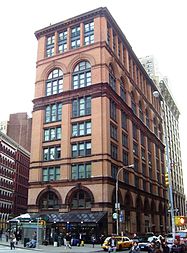- Astor Opera House
-
 The Astor Opera House in 1850
The Astor Opera House in 1850
The Astor Opera House, also known as the Astor Place Opera House and later the Astor Place Theatre,[1] was an opera house in Manhattan, New York City, located on Lafayette Street between Astor Place and East 8th Street. It was designed by Isaiah Rogers and opened in 1847 with a performance of Ermani.[2]
The theatre was built with the intention of attracting only the "best" patrons, the "uppertens" of New York society, who were increasingly turning out to see European singers who appeared at local venues such as Niblo's Gardens. It was expected that an opera house would be
a substitute for a general drawing room – a refined attraction which the ill-mannered would not be likely to frequent, and around which the higher classes might gather, for the easier interchange of courtesies, and for that closer view which aides the candidacy of acquaintance.[3]
In pursuit of this agenda, the theatre was created with the comfort of the upper classes in mind: benches, the normal seating in theatres at the time, were replaced by upholstered seats, available only by subscription, as were the two tiers of boxes. On the other hand, 500 general admission patrons were relegated to the benches of a "cockloft" reachable only by a narrow stairway, and otherwise isolated from the gentry below,[2] and the theatre enforced a dress code which required "freshly shaven faces, evening dress, and kid gloves."[4]
Partly, limiting the attendance of the lower classes was intended to avoid the problems of rowdyism which plagued other theaters in the entertainment district at the time, especially in the theatres on the Bowery. Nevertheless, it was the deadly Astor Place riot in 1849 – provoked by competing performances of Macbeth by English actor William Charles Macready at the Opera House (which, not being able to sustain itself on a full season of opera, was operating under the name "Astor Place Theatre") and American Edwin Forrest at the nearby Broadway Theatre – which caused the theatre to close permanently, being unable to overcome the reputation of being the "Massacre Opera House" at "DisAster Place."[5] By May 1853, the interior has been dismantled and the furnishings sold off, with the shell of the building sold for $140,000[6] to the New York Mercantile Library, which renamed the building "Clinton Hall".[7] In 1890, in need of additional space, the Association tore down the opera house building, and replaced it with an 11-story building, also called Clinton Hall, which still stands on the site.[8]
References
- Bibliography
- Burrows, Edwin G. & Wallace, Mike (1999). Gotham: A History of New York City to 1898. New York: Oxford University Press. ISBN 0195116348.
- Notes
- ^ Not the same as the current Astor Place Theatre
- ^ a b Burrows & Wallace p.724
- ^ Nathaniel Parker Willis, quoted in Burrows & Wallace, p.724
- ^ Burrows & Wallace, p.760
- ^ Burrows & Wallace, p.765
- ^ "The Mercantile Library" New York Times (June 1, 1854)
- ^ "Exclusiveness" New York Times (May 27, 1853)
- ^ White, Norval & Willensky, Elliot (2000). AIA Guide to New York City (4th ed.). New York: Three Rivers Press. ISBN 0812931076.
External links
 Media related to Astor Place riot at Wikimedia Commons
Media related to Astor Place riot at Wikimedia Commons
Categories:- Opera houses in the United States
- Music venues in Manhattan
- Defunct buildings and structures in Manhattan
- 19th century in the United States
Wikimedia Foundation. 2010.

